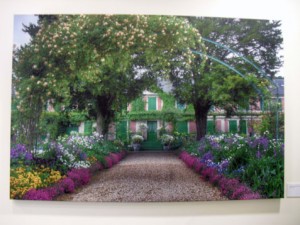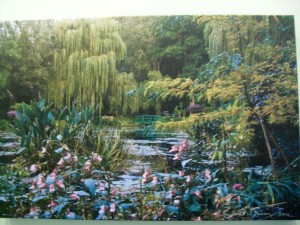Stop and Smell the Roses in Monet’s Garden
By Ishaw Thorpe
Bronx Journal Reporter
“My most beautiful work of art is my garden.” – Claude Monet
 “Monet’s Garden is the latest in a series of exhibitions devoted to great figures whose gardens have played an important role in their lives and works,” explains New York Botanical Garden Science Media Manager Stevenson Swanson, describing the exhibit honoring French Impressionist Claude Monet now through Oct. 21.
“Monet’s Garden is the latest in a series of exhibitions devoted to great figures whose gardens have played an important role in their lives and works,” explains New York Botanical Garden Science Media Manager Stevenson Swanson, describing the exhibit honoring French Impressionist Claude Monet now through Oct. 21.
Walking into the Botanical Garden, one of the first things you will notice are visitors rushing towards the Enid A. Haupt Conservatory. Even though there are several others exhibits at the Garden, most visitors seem really intrigued by what was being displayed in the conservatory. I quickly understood why.
A banner reading “Monet’s Garden” above the Rondina and LoFaro Gallery doors, was attracting visitors as soon as they stepped foot in the garden.
The Monet’s Garden exhibit pays homage to Claude Monet, also known as Oscar Claude Monet, or Claude Oscar Monet. Monet, known as the founder of Impressionist art, was born in Paris on Nov. 18, 1840. He showed his first painting in 1865, in a state sponsored salon. In 1868, he attempted suicide, due to financial pressures, by jumping off a bridge in France. Luckily his attempt failed.
Instead, he produced over 2,500 paintings and 500 drawings in his lifetime, allowing him to change the history of art as we all know it. Sadly, on Dec. 5, 1926, Monet lost his battle with lung cancer and passed away at the age of 86.
The Monet’s Garden exhibit, which is split up in several sections, includes pictures of Monet, his drawings, the pallet he used to create his masterworks and, of course, the flowers that he grew in garden in the late 19th and early 20th centuries.
The first exhibit features pictures of Monet and a couple of his paintings. Walking in, I immediately saw several pictures of Monet working on his garden. From the receipts for the plants he bought, to seeing him weed and plant them, Monet was very committed to his garden. He went about creating it with perfectionistic zeal, much like he did his art.
“I didn’t know how flowers were so important to him.” said Garden visitor Katie Bellisimo, 29.
In the next rooms, no photos were allowed. I knew things were going to get a lot more interesting.
Inside, there were two paintings, “The Artist’s Garden in Giverny” and “Irises.” Both are portraits of flowers in Monet’s garden. One is being shown for the first time in the United States. Alongside the paintings is Monet’s sizable palette that he used for all his paintings. To look at it and see the spots of the different colors of paints that had dried on it for all these years, really made Monet come to life to me, if just for a few seconds.
Exiting this room and walking down to the first floor, you can see pictures and illustrations of Monet’s present day garden and home. It is clear that Monet’s masterpiece garden is still being well maintained in his memory.
And, then, finally the garden, a replica of Monet’s front yard in Giverny, France. The exhibit was extremely hot and humid. I felt like I was in an actual garden on a hot summer day.
Visitors can see the front of Monet’s house and then flowers on the sides of the home’s walkway. Extremely small bugs were flying around these flowers, the mirror image of Monet’s, adding yet another realistic touch. It truly felt as if I was at Monet’s home, walking through his garden, hoping not to get stung by a bee!
Crystal Roberts, 54, said that she read about Monet’s Garden in some magazines and wanted to see what it was about. When asked if the Garden did a good job of honoring Monet with the exhibit, I couldn’t help but notice the big smile she gave me before simply replying “Absolutely.”
As you walk through a pair of doors, you see a pond with various lilies, along with exotic fish that swam underneath and around them. Looking to my right, a group of Hispanic children jumped and screamed with excitement at the fish, yelling “Mirar, Mirar” and “Hola pescado!”
When I asked the NYBG’s Swanson what the Garden wanted its visitors to leave with and to understand about Monet, he declared, “In the words of Gregory Long, Chief Executive Officer and the William C. Steere Sr. President of the Garden, ‘We hope visitors will learn about the profound connections between art and nature.’”
Having never been to a botanical gardens, I’m glad to say that Monet’s Garden was worth the trip. However, if you want to experience this amazing exhibit, I suggest you hurry as it will only be at the Botanical Garden until October 21.








